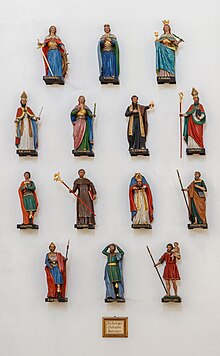|
Fourteen Holy Helpers
 The Fourteen Holy Helpers (German: Vierzehn Nothelfer, Latin: Quattuordecim auxiliatores) are a group of saints venerated together by Catholics because their intercession is believed to be particularly effective, especially against various diseases. This group of Nothelfer ("helpers in need") originated in the 14th century at first in the Rhineland, largely as a result of the epidemic (probably of bubonic plague) that became known as the Black Death. History of venerationDevotion to the fourteen Holy Helpers began in Rhineland, now part of Germany, in the time of the Black Death.[2] Among the fourteen were three virgin martyrs. A German mnemonic for them says:
As the other saints began to be invoked along with these three virgin martyrs, they were represented together in works of art. Popular veneration of these saints often began in a monastery that held their relics. All of the saints except Giles were accounted martyrs. Saint Christopher and Saint Giles were invoked against the plague itself. Saint Denis was prayed to for relief from headache, Saint Blaise against ills of the throat, Saint Elmo, against abdominal maladies, Saint Barbara against fever, and Saint Vitus against epilepsy. Saint Pantaleon was the patron of physicians, Saint Cyriacus invoked against temptation on the deathbed, and Saints Christopher, Barbara, and Catherine of Alexandria for protection against a sudden and unprovided-for death. Saint Giles was prayed to for a good confession, and Saint Eustace as healer of family troubles. Domestic animals were also attacked by the plague, and so Saints George, Elmo, Pantaleon, and Vitus were invoked for their protection. Saint Margaret of Antioch is the patron of safe childbirth.[2] As the saints' joint cultus spread in the fifteenth century, Pope Nicholas V attached indulgences to devotion of the Fourteen Holy Helpers, though these no longer apply.[2] While each had a separate feast day, the Fourteen Holy Helpers were in some places celebrated as a group on 8 August, but this celebration never became part of the General Roman Calendar for universal veneration.[4] When that calendar was revised in 1969,[5] the individual celebrations of St Barbara, St Catherine of Alexandria, St Christopher, and St Margaret of Antioch were dropped, but in 2004 Pope John Paul II reinstated the 25 November optional memorial of Catherine of Alexandria, whose voice was heard by Saint Joan of Arc. The individual celebrations of all fourteen are included in the General Roman Calendar as in 1954, the General Roman Calendar of Pope Pius XII and the General Roman Calendar of 1960. Comparable to the devotion of the Fourteen Holy Helpers was that of the Four Holy Marshals, who were also venerated in the Rhineland as "Marshals of God". These were Quirinus of Neuss, Saint Anthony the Great, Pope Cornelius, and Saint Hubert.[6] The Auxiliary SaintsThe fourteen saints are:
Half the saints are regarded as historical figures (Blaise, Cyriacus, Erasmus, George, Giles, Pantaleon, Vitus) while the other may be only legends (Agathius, Barbara, Catherine of Alexandria, Christopher, Denis, Eustace, Margaret of Antioch).[11] In the case of the latter group, their supposed "legendary" status is primarily based on analysis of the saints' traditional hagiographies alone with out due consideration of other possibilities and interpretations, as well as the changes associated with the Mysterii Paschalis, irrespective of which changes actually applied to these particular saints — in the instance of the Fourteen Holy Helpers, while the feasts were in several cases removed from the General Roman Calendar, none were decanonized or were denied as having existed to begin with (furthermore, their feasts remain on particular calendars). For one or another of the saints in the original set, Anthony the Anchorite, Leonard of Noblac, Nicholas, Sebastian, Oswald the King, Pope Sixtus II, Apollonia, Dorothea of Caesarea, Wolfgang of Regensburg or Roch were sometimes substituted. In France an extra "helper" is added: the Virgin Mary.[12] The Basilica of the Vierzehnheiligen The Fourteen Holy Helpers are honored in Bavaria as the vierzehn Heiligen, and the Basilica of the Vierzehnheiligen is dedicated to these auxiliary saints. The Rococo pilgrimage church near the town of Bad Staffelstein was designed by Balthasar Neumann and built between 1743 and 1772.[13] Devotion to these saints began in that region on 24 September 1445 when Hermann Leicht, the young shepherd of a nearby Franciscan monastery, saw a crying child in a field belonging to the nearby Cistercian monastery of Langheim. As he bent down to pick up the child, it abruptly disappeared. A short time later, the child reappeared in the same spot. This time, two candles were burning next to it. In June 1446, Leicht saw the child a third time. This time, the child bore a red cross on its chest and was accompanied by thirteen other children. The child said: "We are the fourteen helpers and wish to erect a chapel here, where we can rest. If you will be our servant, we will be yours!" Shortly after, Leicht saw two burning candles descending to this spot. It is alleged that miraculous healings soon began, through the intervention of the fourteen saints.[14] The Cistercian brothers to whom the land belonged erected a chapel, which immediately attracted pilgrims. An altar was consecrated as early as 1448. Pilgrimages to the Vierzehnheiligen continue to the present day between May and October. Depiction in cultureOne of the group depictions of the fourteen Saints is a 1503 altarpiece by Matthias Grünewald for the monastery in Lichtenfels in Upper Franconia. The fourteen angels of the lost children's prayer in Engelbert Humperdinck's fairy opera, Hansel and Gretel, symbolize the Fourteen Holy Helpers.[15] The English words are familiar:
Gallery
See also
Further reading
References
External linksWikimedia Commons has media related to Fourteen Holy Helpers. |
|||||||||||||||||||||||||||||||||||||||||||||||||||||||||


